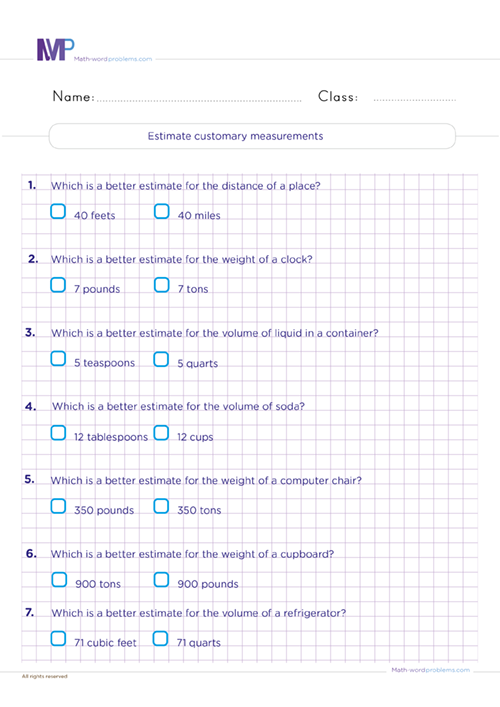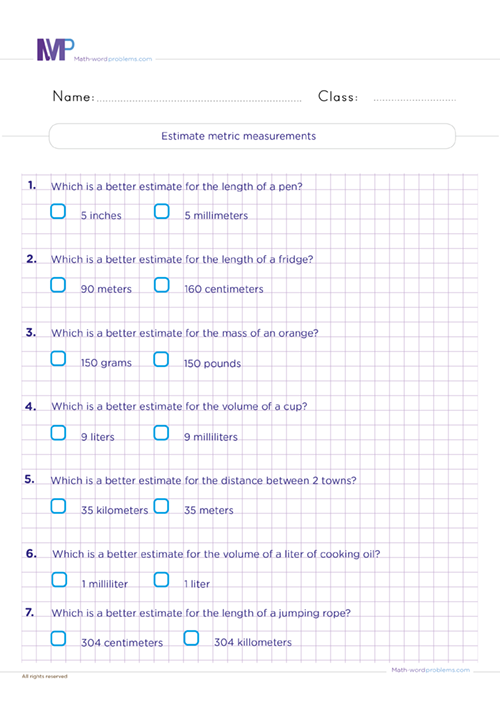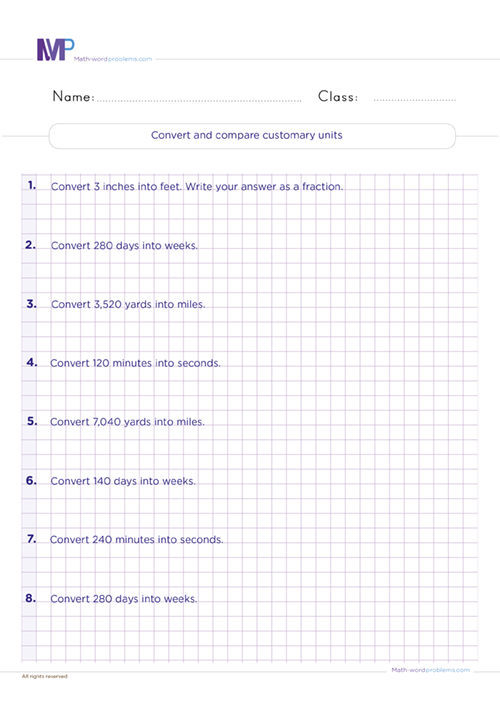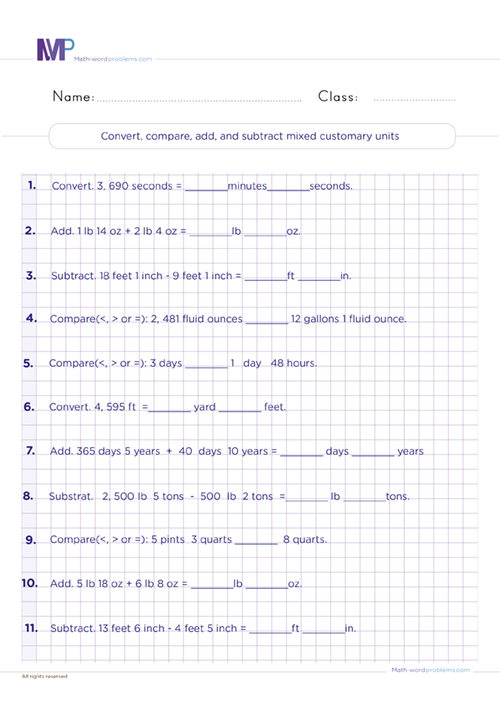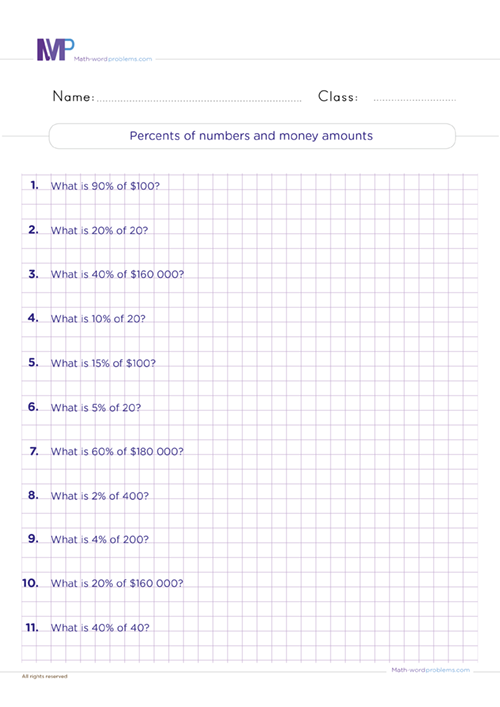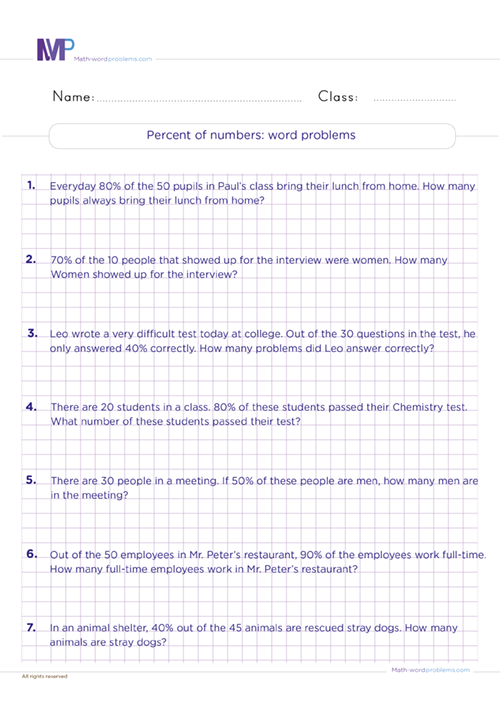 Units of measurements worksheets Grade 6
Units of measurements worksheets Grade 6

- INTRODUCTION
- Download worksheets
- Related Contents
- Why are units of measurement worksheets Grade 6 important in...
Get more contents on Units of measurements 6th Grade...
Your 6th graders will have fun comparing, converting, and estimating units of measurement worksheets Grade 6. This resource covers exercises on customary and metric units of length, weight, capacity, and time and captivating word problems involving real-life situations that will enhance 6th graders' thinking and reasoning skills. As we know, the customary units used only in the United States include inches, feet, miles, pounds, cups, gallons, etc. On the other hand, the metric system is used in Britain and every other country outside the U.S.A. Its units of measure include millimeters, centimeters, meters, kilometers, milliliters, liters, grams, and kilograms.
With this in mind, we will produce worksheets wherein 6th graders will effortlessly learn how to convert units within the same system and from one system to another. In addition, they will practice comparing, converting, and estimating customary and metric units length, weight, capacity, volume, time, temperature, etc.
While mastering the different measuring units and systems, it is important to note that to convert from one unit to another, we either multiply or divide by the factor, depending on whether we want to change to a larger or smaller unit. For instance, when converting customary units from a larger to a smaller unit, we multiply the larger unit by its smaller equivalent unit, and the reverse is true for division. The ability of kids to master this measuring unit concept at an early age will help them visualize, measure and interpret measures in math and real life most accurately.
Metric conversion worksheet with answers grade 6
Hey kiddos! Our customary and metric conversion worksheet with answers grade 6 has been designed to offer the best and simple tricks for converting units of measure within the same system or from one system to another. Unit conversion is changing one measurement unit to another, such as inches to centimeters, pounds to kilograms, gallons to liters, etc. Since different countries and regions use different measurement systems, it is essential to master these different conversion skills because they can help us solve problems, make better decisions, and communicate effectively in any country you find yourself.
It is amazing to note that our units of measurement worksheets Grade 6will design a variety of conversion exercises. However, you must know the relationship between units of a system before converting. For instance,
-To convert units within the customary system;
- 1 foot = 12 inches,
- 1 pound = 16 ounces,
- 1 quart = 4 cups.
-To convert units from one system to another,
- 1 inch = 2.54 centimeters
- 1 inch = 2.54 centimeters,
- 1 pound = 0.4536 kilograms,
- 1 gallon = 3.785 liters.
You must equally note that you can multiply or divide by a factor depending on whether you want to change to a larger or smaller unit. For example,
- To convert 3 feet to inches, you need to multiply by 12 because inches are smaller than feet. For instance, 3 feet x 12 = 36 inches.
- To convert 36 inches to feet, you must divide by 12 because feet are larger than inches. For instance, 36 inches / 12 = 3 feet.
With constant practice in these worksheets, your kids will acquire the best unit conversion skills, as we'll provide them with challenging yet simple exercises and fun-solving strategies. In most cases, we often encourage kids to make reasonable guesses before performing this exercise. By so doing, they'll develop genuine estimation skills, which are equally helpful for checking the reasonableness of their answers and for solving problems when exact measurements are not available or required.
For example, if you want to buy a new fridge for your kitchen, you may not need to know the exact dimensions of the kitchen, but you can estimate if it will fit or not by using some reference units such as feet or meters.

Why are units of measurement worksheets Grade 6 important in math and real life?
You may wonder why units of measurement worksheets in Grade 6 are important in math and real life. These worksheets will reinforce your understanding of unit conversion and its importance in real life while preparing you for more advanced math topics such as ratios and proportions.
We communicate measurements and quantities everyday without even realizing it. For instance, you often say, "give half a glass of water." However, formal practice and understanding of our unit measuring worksheets will enable you to efficiently measure, estimate or compare varying objects and phenomena using a common language and system.
Basic metric system units, prefixes, and common uses include:
- A meter is a basic unit of length in the metric system used to measure long distances and heights.
- 1 millimeter (mm) = 0.001 meters (m): used to measure short distances, like a fingernail
- 1 centimeter (cm) = 0.01 meter (m): used to measure average distances, like a pen
- 1 kilometer (km) = 0.001 meters (m): used to measure very long distances
- 1 milliliter (ml) = 0.001 liters (l): used to measure small volumes like a drop of water
